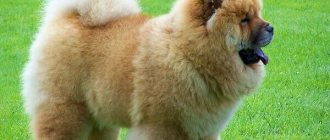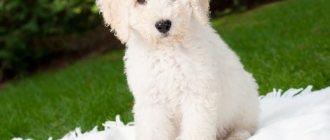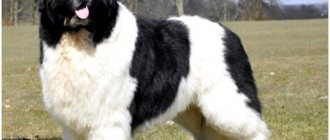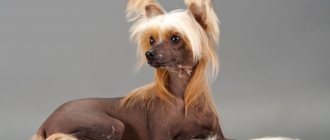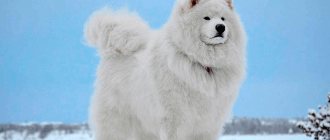Papillon (Papillon) is a breed of decorative companion dogs. The official name is “Continental Toy Spaniel.” Translated from French, “papillon” means “butterfly”. Distinctive qualities:
- cute appearance;
- large movable ears reminiscent of butterfly wings;
- light graceful movements;
- almost human character;
- high intelligence (they are in 8th place in the ranking of the smartest dogs);
- impeccable memory;
- curiosity;
- people-oriented;
- loyalty, friendliness;
- security qualities;
- hunting instincts.
a brief description of
| Height: up to 28 cm Weight: from 1.5 kg There are 2 categories:
How much does a puppy cost:
Life expectancy: 12-15 years. |
What is the difference between Papillons and Phalenes? | Phalene (translated as "moth") is a type of breed. The main difference is the different shape and position of the ears; the Phalene has drooping ears, while the Papillon has erect ears. They also differ in character and behavior. Papillons are more mobile, Phalenes behave calmer. |
Who is the breed suitable for? | For beginners, active people. This is not a pampered sofa dog, you can take it to the forest, on a hike, on trips, the pet will not mind frolicking in a noisy company. Not suitable for busy people, families with small children (a child may accidentally injure a small dog). |
Boys and girls: what are the differences in character? | Girls are more affectionate, emotional and tender. Boys look more impressive, more courageous and decisive. However, they can mark in the apartment. |
Does a Papillon have a lot of hair? | They don't shed very much because they don't have undercoat. During the shedding period, daily brushing is necessary. |
Is it possible to cut hair? | Clipped Papillons are not allowed to show, but non-show dogs can be cut. |
Do you need clothes for walking in the cold season? | Yes, but in extreme cases: if there is a lot of wet snow or severe frost outside. Such dogs are very mobile, so they are not threatened by the cold. |
Do they bark often? | No. They only speak out when there are suspicious sounds. They can bark if they get too excited. |
Pros:
- Smart, obedient, highly trainable.
- They successfully participate in agility and other dog sports.
- Convenient in everyday life and handling.
- You can take it with you on trips.
- They don't bark for no reason.
- Playful, cheerful.
- They are distinguished by good health.
- Kind and affectionate with all family members.
- They treat children warmly.
- Get along well with pets.
Minuses:
- The coat, ears and eyes require constant care.
- Physical activity is required.
- With a lack of attention they become irritable.
- Sometimes they show aggressiveness (mainly due to improper socialization).
- They can bite painfully.
- They are affectionate and cannot be left alone.
- Jealous, touchy.
How to choose a puppy
The Papillon is a fairly expensive dog, so many people buy puppies from private individuals . Most often, such pets do not have a pedigree, vaccinations or passport, and there are also no guarantees for the purebred and good health of the baby. All necessary documents are prepared at the official nursery. The breeder will tell you about the conditions for keeping the puppies, their regime and diet. In addition, there is an opportunity to evaluate the dogs' parents.
- Healthy puppies will be playful and curious.
- They must meet the characteristics of the standard and not have congenital pathologies.
- The cost of such a pet depends on its class.
- Without a pedigree, a puppy will cost 12,000-15,000 rubles, pet class - up to 30,000 rubles, breed class and show class - from 60,000 rubles.
- First of all, you need to decide for what purpose you are buying a dog. If as a pet, then a pet is suitable, and if for breeding and exhibitions, then a show class.
Photo papillon
Character, behavioral characteristics
Papillon dogs are distinguished by a balanced character; nervousness is unusual for them. They are friendly, peaceful and sociable towards others. These are positive, energetic, active dogs. They love to frolic and will not sit still. Even at home, they are constantly looking for something to do. On the street they actively study the world around them, hunt insects and rodents.
They are vulnerable, cannot stand rough treatment, and even suffer from shouting. It should be noted that if socialized incorrectly, a dog can instantly switch from play to rage. Papillon bites are very painful.
Learning ability
They are inquisitive and show interest in everything new. They are very smart, obedient, have an excellent memory, and a keen intellect. Commands are learned quickly and easily. A dog can be taught a wide variety of tricks.
Attitude towards the owner and children
They are infinitely loyal to their owner and prefer to be nearby. They subtly sense the mood of the people around them. They need attention and affection. When alone they experience stress, and with a lack of communication they become irritable. In the company of the owner, they easily adapt to changing conditions and tolerate trips and travel well.
They love children, are very friendly, and take part in games with pleasure. However, a small child should not be left alone with a dog: if handled carelessly, the pet may become aggressive. Papillon care can be entrusted to a child from 10 years old.
Attitude towards strangers
They are distrustful, show restraint, and are wary. Representatives of the breed are distinguished by good watchdog qualities. These are sensitive and attentive guards, but they will not bark in vain. If necessary, they will actively protect the owner.
Attitude towards pets
Get along well with other pets, including cats. They often become initiators of joint games in which they take an active part. If the owner is often not at home, it is recommended to get another dog or cat so that the Papillon does not feel lonely. Larger relatives are treated very carefully on the street.
Pros and cons of the Papillon breed
Before buying a puppy, it is better to immediately assess your strengths by analyzing all the advantages and disadvantages of the breed. The main strengths that the Continental Toy Spaniel has:
- High IQ. These are the smartest of all decorative dogs.
- Cheerfulness, intelligence and curiosity. This makes the puppy easy to raise, socialize and train.
- Devotion to the owner. The dog is ready to wait for its owner from work, to keep him company on travel and business trips.
- Friendly disposition towards strangers, children and other animals.
The disadvantages of the Papillon include:
- The amount of how much a Papillon costs. For a purebred puppy in nurseries they ask from $300 to 500, and even more for a show-class pet.
- The disadvantage of the breed is its loud, causeless barking, which can only be mitigated by quality education.
- Much attention needs to be paid to caring for the dog’s coat, which takes both time and financial resources.
- Pets have a tendency to be overweight and have some genetic diseases.
Maintenance and care
It can be kept in a small apartment or in a country house with adjacent territory. In any case, a daily walk is necessary, at least 2 times for 20-30 minutes. It is not advisable to train the dog to the tray; the dog should have plenty of exercise. She needs active and eventful walks. Papillons are clean and try not to get dirty. At home, you just need to wash your pet’s paws.
Hair care: combing with a metal comb 2 times a week, during the shedding period - daily. Using a spray bottle, pre-moisten the coat with conditioner diluted with water. The tangles need to be cut off. You should not comb dirty, dry hair, as this will cause the hair to become brittle.
Combing ear fur: Spray with shine product diluted with water and comb. If tangles appear, treat the hair on the ears with anti-tangle spray, then carefully remove the lumps and comb the hair.
Grooming: non-show dogs only. A popular haircut is “lion-like,” when the hairline is shortened on the body. For hygienic purposes, all individuals must have the hair trimmed on their paws, between the toes, at the anus, and in the groin area. To make the dog look neat, also trim the elongated hairs on the belly, the inside of the pastern (to the pads). On the hind legs, even out the fur on the metatarsus (up to the hocks).
Bathing: 1 rub./week. or due to contamination. Frequent washing is not recommended, otherwise the skin will become too dry. Use a special shampoo that will not give the coat a yellow tint. How to bathe:
- Mix shampoo with a little water.
- Moisten the dog's fur.
- Apply shampoo, first to the back, then to the sides and legs.
- Rub in the cleaning solution thoroughly.
- Wash your dog's head; water should not get into the eyes, ears, nose or mouth.
- Rinse off the shampoo with a generous shower.
- Squeeze out the fur with your hands.
- Dry with a towel.
For non-show dogs, natural drying of the coat is recommended. If you use a hair dryer, make sure the air is not too hot. Otherwise, the hairs will become brittle. While drying, you can spray the wool with an oil-based shine product diluted with water in a ratio of 1 to 10.
Paw care includes:
- Trimming claws with a nail clipper - 1 rub. at 2 months The fifth dewclaw needs to be removed at the veterinary clinic; it causes discomfort for the dog when moving.
- Washing paws after a walk. You can simply wipe them with a damp cloth. To prevent cracks from appearing, rub vegetable oil into the pads.
Ear care: regular inspection, cleaning with a cotton pad moistened with water.
Dental care: brushing 2-3 times/week. To prevent tartar from appearing, give your pet solid food, special toys, and rawhide chips.
Eye care: 1 rub./week. wipe with a cotton swab moistened with chamomile infusion or warm water. If tear tracks appear, use special lotions.
Interesting Facts
The Papillon is a very emotional dog; all shades of mood can be seen on its small face. Despite its small size, this breed is recognized as one of the smartest.
The Papillon dog has become popular for the following reasons:
- The breed was developed in the 17th century. The first favorites appeared at the court of Marie Antoinette; this was a very expensive breed.
- There is a close relative of the breed that differs only in the ears, so they are easy to confuse. Many dishonest nurseries pass off Phalene as Papillon.
- Dogs have an aggressive character and can easily bite their offender.
The main feature of the breed is its emotionality. You can immediately see from a dog when he is sad, when he is angry or in the mood for a game. It is considered a good companion for an adult and active person.
Health, tendency to disease
Papillons are distinguished by good health, but are still prone to certain diseases:
- Entropy (turn of the century). It is characterized by a change in the position of the organ, with the edge of the upper or lower eyelid and eyelashes touching the eyeball. As a result, chronic inflammation develops. The consequences are ulcers and blindness. Symptoms of the disease: squinting of the affected eye, lacrimation, purulent discharge. Treatment is surgical; if anesthesia is intolerant, autohemotherapy is performed.
- Cataract. Eye disease, the main symptom is clouding of the lens. Due to visual impairments, the dog moves carefully and sometimes bumps into objects. Pathology leads to blindness. The only treatment is surgical; during the operation, the clouded lens is replaced with an artificial one.
- Dystrophy of the cornea of the eye. It manifests itself as a decrease in the transparency of the cornea. Symptoms: swelling, clouding of the cornea, the appearance of erosions, ulcers, blurred vision. Treatment includes the prescription of antibiotics and topical drugs (including atropine). Late stage disease is treated surgically.
- Congenital deafness. The pathology is associated with a defective gene or caused by intrauterine infection, toxic factors that acted on the body in the prenatal period. The puppy is born deaf and remains so for the rest of its life. The use of special devices is ineffective.
To identify pathology, just clap your hands and look at the animal’s reaction. Individuals with this disorder are not allowed to be bred. Deaf dogs adapt to the lack of hearing and lead normal life activities, since their perception is balanced by increased vision and smell. Such a pet can be taught commands that are given using gestures.
Choosing a puppy, care, maintenance, education
Pay attention to the conditions of detention and the behavior of the children. When choosing a puppy, consider physical characteristics. The main criteria are indicated in the breed description:
- correct proportions of body parts;
- correct position of the tail and limbs;
- coat color corresponding to the standard;
- lack of nervousness, aggression.
Look at the documents issued to the puppy's parents:
- Pedigree.
- Breeding certificate with the dog's assessment. It is necessary that the document contains a note indicating permission for breeding.
- Breeding passport indicating the date of mating. There must be at least 9 months between two litters.
Metrics are issued for babies, as well as veterinary passports (if vaccination has been carried out). The purchase of an animal is formalized by a purchase and sale agreement, which has legal force. A pedigree for a puppy is obtained from the kennel club; it is issued on the basis of metrics.
Maintenance and care
Prepare a place for the puppy - a mattress or bed. Take care of your baby's safety in advance. For this:
- Raise all wires to a height inaccessible to the dog.
- Remove sharp, breakable, small objects, and household chemicals.
- Check that cabinet doors close securely.
- Hide books and shoes in a safe place.
For the first time, it is recommended to allocate space by fencing off a corner of the room. You can purchase a special enclosure. Place a sleeping place, newspapers or diapers, and toys there. When the puppy grows up, the enclosure is removed.
Buy 2 ceramic or stainless steel bowls. A soft nylon or leather collar 1 cm wide is suitable for ammunition. Using a harness is not recommended.
The puppy will need toys: a ball made of molded rubber, objects made of latex. During the period of teeth change, you can give him branches and peeled carrots.
Caring for Papillon puppies includes hygiene of the ears, eyes, and teeth. The frequency of necessary procedures is the same as for adults. Brush the fur regularly, then the pet will look well-groomed.
Walk your baby daily, 3-5 times a day for 15 minutes. (after sleep and after feeding). In bad weather, reduce your walking time. For your first walks, choose quiet places, then increase the number of stimuli. Starting from the age of 3 months, gradually accustom your pet to city noise, crowds of people, and travel in public transport. Make sure that the puppy does not experience negative emotions during the walk.
Education and training
Start parenting from the moment the baby appears in the house. The younger the dog is, the easier it is to win her over. The pet needs to be taught the skills of proper behavior. Papillons are very smart and quickly understand what exactly is wanted from them. Be sure to reinforce positive results with encouragement.
You cannot break the established rules. If you do this just once, for example, allowing the dog to sleep on the bed, you will no longer be able to correct the situation. Representatives of the breed do not tolerate rudeness or cruelty; they must be treated very gently.
Do training before feeding. The duration of the 1st lesson should not be longer than 15-20 minutes. To prevent your puppy from getting tired, teach him no more than 2 commands in 1 lesson. Gradually increase the training time to 40 minutes, and the number of skills to 3. It is recommended to sign up for classes with an instructor when the puppy is 4-7 months old. Papillons are distinguished by excellent physical characteristics, so they can successfully participate in sports competitions: agility, freestyle, flyball, frisbee.
Features of training and education
An active and cheerful Papillon needs training from a very early age. Otherwise, the owners will experience inconvenience with him.
First, the puppy must remember its name.
Then he is accustomed to his place, prohibited from sleeping with his owners, biting them and damaging furniture.
Then you can teach him simple commands: “sit”, “lie down”, “near”, “voice”, “come to me”, etc.
Feeding
A balanced diet is an important condition for maintaining health. If the menu is compiled correctly, the dog is playful, and its coat does not lose its natural shine. Feeding bulky, low-calorie diets is unacceptable; this will lead to changes in the development of the skeleton, internal organs, and disturbances in the exterior of the growing dog. Food that is too high in calories will cause obesity and your pet will look too massive.
The diet should include food of animal and plant origin. What to feed:
- meat (beef, veal, rabbit) – raw, scalded with boiling water;
- boiled offal (liver, kidneys, udder, heart, lungs);
- porridge (buckwheat, oatmeal, rice, corn);
- fermented milk drinks and products;
- sea fish (boil, remove bones) – 1 rub./week;
- egg yolk - 1 rub./week;
- raw vegetables and fruits (finely chopped).
Food must be fresh. Unrefined vegetable oil will be useful; it is given in 0.5 table doses. l. per day, several days in a row. Such courses are conducted 2-3 rubles/year.
Papillons have fragile bones, so your pet needs to be fed foods rich in calcium. The puppy is given milk, diluted with water in a 1:1 ratio. It is recommended to add bone meal, milk powder, seaweed powder, and chalk to the main food. Once a week you can give a sugar pit (fresh).
How many times a day to feed:
- 1.5-3 months. - 6-8 rubles;
- 4-5 months - 4-5 rubles;
- 6-9 months - 3-4 rubles;
- 9-12 months – 2-3 r.
- from 1 year - 2 rubles.
You cannot give food from the table, it contains too much fat, salt, and spices. Other prohibited products:
- tubular bones;
- fried, smoked;
- sausages;
- potatoes, legumes;
- cheese;
- pork;
- chocolate, sweets;
- River fish;
- flour.
Do not overfeed your dog, this will have a negative impact on health. If the puppy eats with great appetite and is clearly overeating, you need to strictly dose the food. Give food at the same time, then wash and put away the bowl. Don't distract your dog while eating. You should not go for a walk immediately after feeding; take your pet for a walk 30 minutes after he has eaten.
Breeding
Start breeding Papillon dogs by selecting sires. Breeding individuals should not have hereditary pathologies or other health problems. Dogs that have received a rating of no lower than “very good” are allowed to undergo planned mating. The optimal age for mating is 2 years. Early matings delay the development of the body; in addition, the offspring will not be viable.
The male and female dogs must be well-fed, but not overweight; they are treated for fleas and given anthelmintic drugs. The favorable time for conception is 9-15 days from the start of estrus. It is recommended to carry out 2 matings. Signs of a female dog in heat:
- swelling of the loop during ovulation;
- characteristic behavior - sexual hunting (arching of the back, abduction of the tail);
- male sexual activity.
Pregnancy usually proceeds without complications. During this period, the dog needs careful treatment. Do not pick her up, limit physical activity during walks. In the second half of pregnancy, increase the volume of your diet. You need to buy vitamin and mineral complexes. 10 days before the expected birth, it is recommended to reduce the amount of protein foods.
Prepare a spacious place and place a clean cloth there. The day before giving birth, trim the hair on the dog’s belly and genital area, and wash these areas. With proper care and adequate assistance, the process will go smoothly, and even the weakest individuals will survive.
Signs of the onset of labor:
- The bitch becomes restless, breathes frequently, trembles, hides in the corner or follows around.
- Pimples appear on the sides as the stomach drops down.
- Heart rate increases.
- Body temperature decreases (by 1-2 °C).
This condition can last 2-3 hours or more (up to 24 hours), then contractions begin. Be there during this time. To make your dog feel less pain, stroke its back and belly.
After the baby is born, the amniotic sac may not rupture, then the owner will have to do this. Next, remove mucus from your puppy's airways using a small rubber bulb. As a rule, the mother dog chews the umbilical cord on its own. If blood appears, lubricate the edges of the umbilical cord with iodine.
Place the puppy on the mother's nipple. When new contractions occur, place the baby in a box that should be in full view of the dog. Put a heating pad there. Childbirth ends with the separation of the placenta (placenta). After this, change the bedding and place the puppies with their mother.
Story
The history of the Papillon breed goes back about 800 years. According to the first version, she was bred in France. It is generally accepted that her ancestors were Italian and Spanish dwarf spaniels.
According to another version, dogs were brought to Europe from China.
Papillons were very popular among nobles. Some of them were ready to pay fabulous sums for the dogs.
FCI standard
| Scull | Not round when viewed from the front or from the side. |
| Stop | Expressed quite well. |
| Nose | Small, round. Black color. |
| Muzzle | Shorter than the cranial part. Pointed, should not be pulled up. |
| Jaws/teeth | Strong. Scissor bite. |
| Language | Should not be visible with the jaws closed. |
| Eyes | Dark in color, shaped like a large almond. Quite large and wide open. Set low. |
| Ears | Set quite wide apart, set closer to the back of the head. Large, with thick fringe. The ends are rounded. Papillons have erect ears, the inner side of the ears is covered with silky, short, slightly wavy hair, the outer side is covered with long hair. Phalenes are distinguished by their floppy ears, which are adorned with long, wavy fur. Interbreeding between species is prohibited because the result is offspring with half erect ears. |
| Neck | Moderate length. Slightly curved at the back of the head. |
| Small of the back | Slightly convex, strong. |
| Stomach | Slightly tucked up. |
| Limbs | Strong, straight. |
| Paws | Long enough. The claws are strong. The pigment matches the color. |
| Tail | Set quite high. Long, richly decorated with wool. If the dog is alert, it throws its tail over its back. |
| Wool | Thick, long, no undercoat. Slightly wavy, but without curls. Short on the head, muzzle, outer surface of the forelimbs, and on the lower part of the hind limbs. Longer on the body. There is a rich “collar” on the neck that extends to the chest. There are feathers on the back of the front paws, and hair covers the hind paws profusely from the croup to the hock. |
| Color | White with spots of any shade. White color predominates on the body and paws. The head is painted symmetrically; a predominant white color is unacceptable. |
| Disqualifying faults: |
|
Historical reference
The ancestors of Papillons appeared in Italy and Spain more than 800-900 years ago. During the Renaissance, the breed became very popular. The most common are those with floppy ears; such dogs can be seen in paintings of the 17th century. Papillons were kept by noble families of France and Belgium. Fans of the breed were Henry III, Louis XIV, Marie Antoinette. After the revolution in 1789, Papillons were on the verge of extinction, but some of the livestock were exported to other countries, in particular to Belgium. The breed began to be revived in the mid-19th century. By the beginning of the 20th century, Papillons became more popular than Phalenes.
In 1905, these dogs came to England, where later it was decided to cross them with Spitz dogs. The resulting offspring were distinguished by excellent quality wool, well-furred ears and tail. In the future, the color of the animals began to change; in addition to white and red, other colors appeared. Through the efforts of English and Scandinavian breeders, the exterior of the breed was significantly improved. In 1923, it was officially recognized by the English Kennel Club. In the USA, the Papillon and Phalene are considered the same breed, but in Europe they are considered different. In Russia, such dogs began to be bred since 2000, and every year they become more and more popular.
Papillon and Chihuahua - differences
When choosing a small pocket dog, many are stuck on the dilemma between the Papillon and the Chihuahua. These two breeds have significant differences in:
- Mental abilities. Continental Terriers are much smarter.
- The desire for stubbornness and dominance. Butterfly dogs will rarely try to push through clearly defined boundaries, while Chihuahuas will try to do this more than once.
- Temperament. The Papillon is more playful, but also calms down much faster. Better suited for families with children.
- A Papillon puppy is absolutely devoid of protective qualities, while a Chihuahua will defend its territory and owner as best it can.



